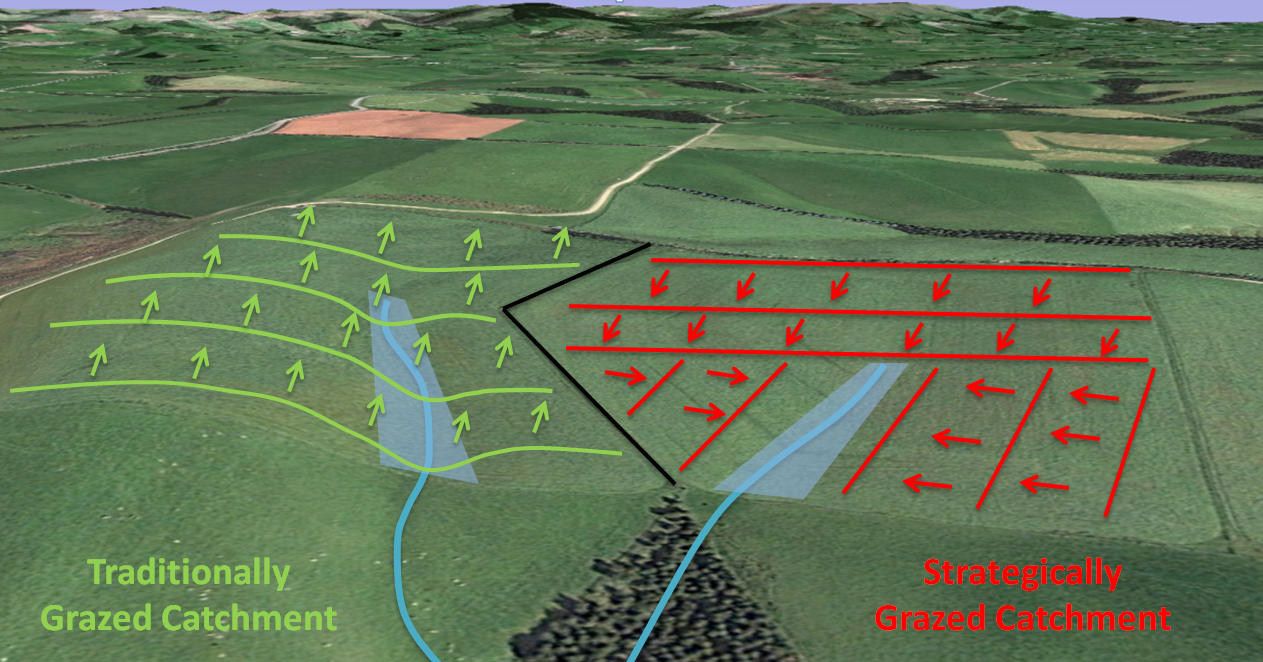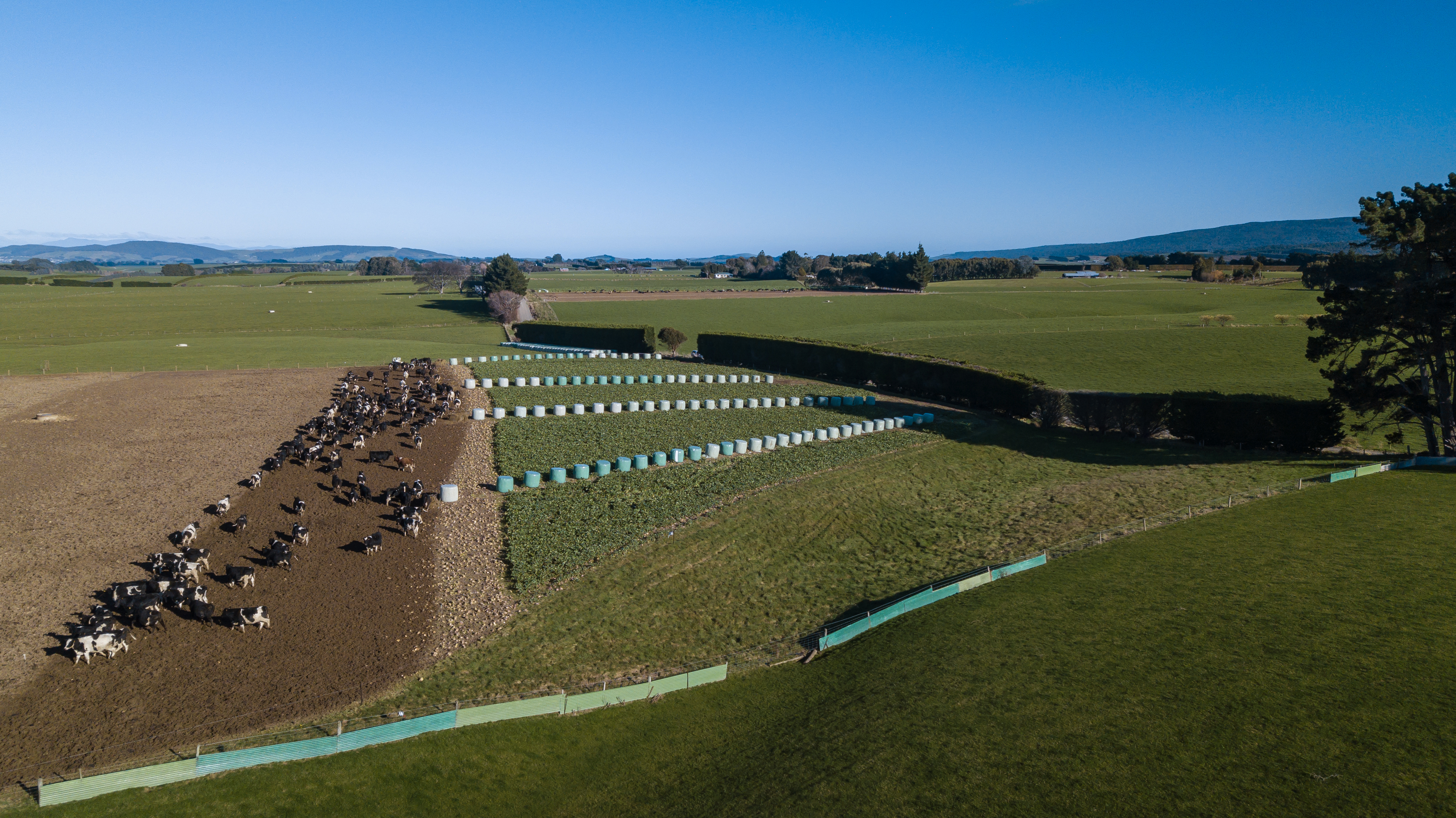Strategic grazing of livestock
What
Strategic grazing, especially around critical source areas, can greatly improve water quality. Even simple grazing changes, such as grazing from the top of the slope to the bottom or leaving a “last bite” strip at the bottom, can result in vast improvements in the amount of contamination entering a waterway. Avoidance of critical source areas would reduce the risk further.
Watch a video from AgResearch Scientists that explains the simple rules used for break feeding animals on winter forage crops to reduce environmental impacts.

Image Source: AgResearch
Why
Winter grazing of a forage crop leads to large losses of nitrogen in drainage, phosphorus attached to sediment and microbes in surface runoff.
Try to avoid grazing in critical source areas altogether. If this is not practical, graze these areas lightly and for a shorter time.
Restricting the time spent grazing a forage crop to 3-4 hrs so animals get maintenance feed requirements can decrease losses via erosion and excretal deposition compared to plots where animals are left in-situ (McDowell and Houlbrooke, 2009; McDowell et al. 2003; 2005). However, this is not suitable in all situations as it can lead to other problems, such as compaction and lameness if the set up does not lend itself well to moving the stock on and off crop. Restricted grazing and off pasture animal confinement systems are other examples of grazing strategies which can be used.
In fully or partially grazed systems, a strategy for minimising N, P, sediment, and E. coli losses is to avoid deposition of urine and faeces or soil disturbance during periods of high loss risk (especially in spring and late autumn where soils are wet and growth is poor), by either removing the animals from pasture at certain times or, when a wintering barn is used, by extending the existing housing period. Measurement and modelling of these “restricted grazing” strategies have been shown to decrease N leaching losses and surface runoff losses of P, E. coli and sediment. The size of these decreases depends on the duration and timing of the restricted grazing period. Disproportionately greater benefits were observed if grazing was restricted shortly preceding or during periods when losses were likely i.e., when drainage or runoff was occurring. Stand-off pads (preferably covered or with fully contained effluent systems), herd shelters and wintering barns are some of the infrastructure options that are required for an off-pasture animal confinement system to work effectively (Cardenas et al. 2011; Christensen et al. 2012; de Klein et al. 2006; Ledgard et al. 2006).

Image source: DairyNZ.
References
Christensen, C. L., Hedley, M. J., Hanly, J. A., & Horne, D. J. (2012). Nitrogen loss mitigation using duration-controlled grazing: Field observations compared to modelled outputs. In Proceedings of the New Zealand Grassland Association (Vol. 74, pp. 115-120). New Zealand Grassland Association.
De Klein, C. A. M., Smith, L. C., & Monaghan, R. M. (2006). Restricted autumn grazing to reduce nitrous oxide emissions from dairy pastures in Southland, New Zealand. Agriculture, ecosystems & environment, 112(2-3), 192-199.
Houlbrooke, D. J., Drewry, J. J., Monaghan, R. M., Paton, R. J., Smith, L. C., & Littlejohn, R. P. (2009). Grazing strategies to protect soil physical properties and maximise pasture yield on a Southland dairy farm. New Zealand Journal of Agricultural Research, 52(3), 323-336.
Ledgard, S., Sprosen, M., Judge, A., Lindsey, S., Jensen, R., Clark, D., & Luo, J. (2006). Nitrogen leaching as affected by dairy intensification and mitigation practices in the resource efficient dairying (RED) trial. Implementing sustainable nutrient management strategies in agriculture. Occasional Report, 19, 263-268.
McDowell, R. W., & Houlbrooke, D. J. (2009). Management options to decrease phosphorus and sediment losses from irrigated cropland grazed by cattle and sheep. Soil Use and Management, 25(3), 224-233.
McDowell, R. W., & Houlbrooke, D. J. (2009). Management options to decrease phosphorus and sediment losses from irrigated cropland grazed by cattle and sheep. Soil Use and Management, 25(3), 224-233.
Monaghan, R. M., Laurenson, S., Dalley, D. E., & Orchiston, T. S. (2017). Grazing strategies for reducing contaminant losses to water from forage crop fields grazed by cattle during winter. New Zealand Journal of Agricultural Research, 60(3), 333-348.